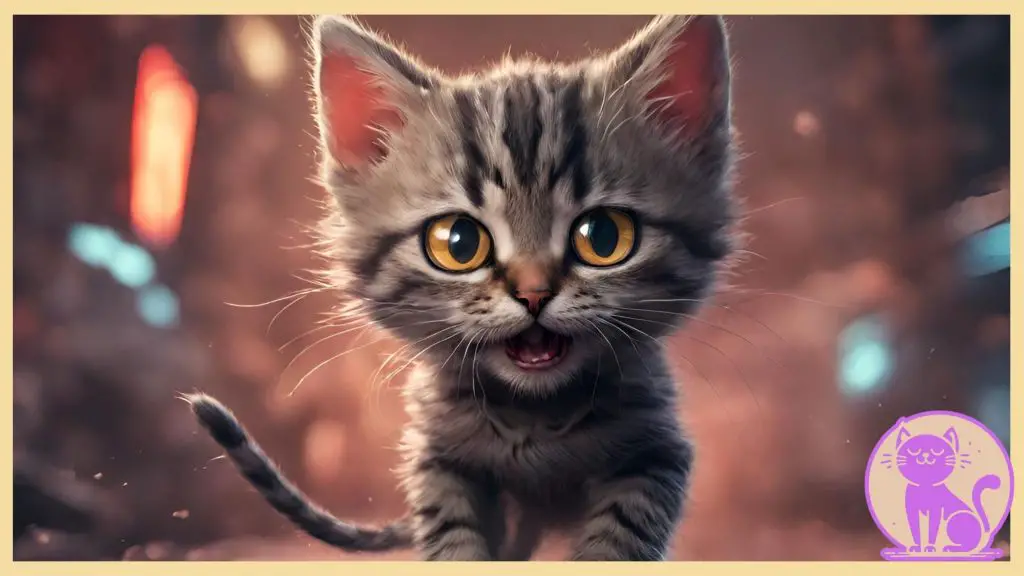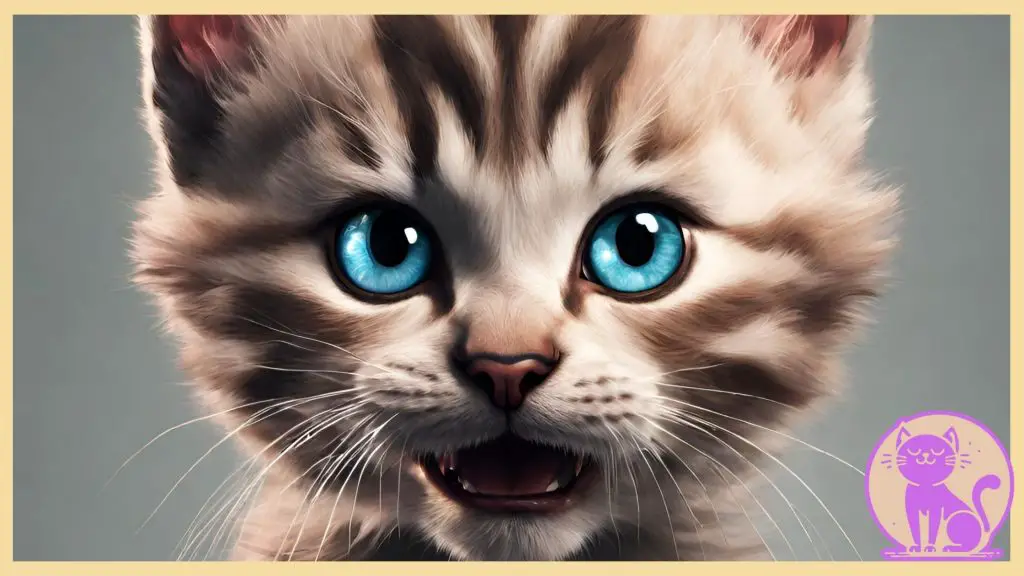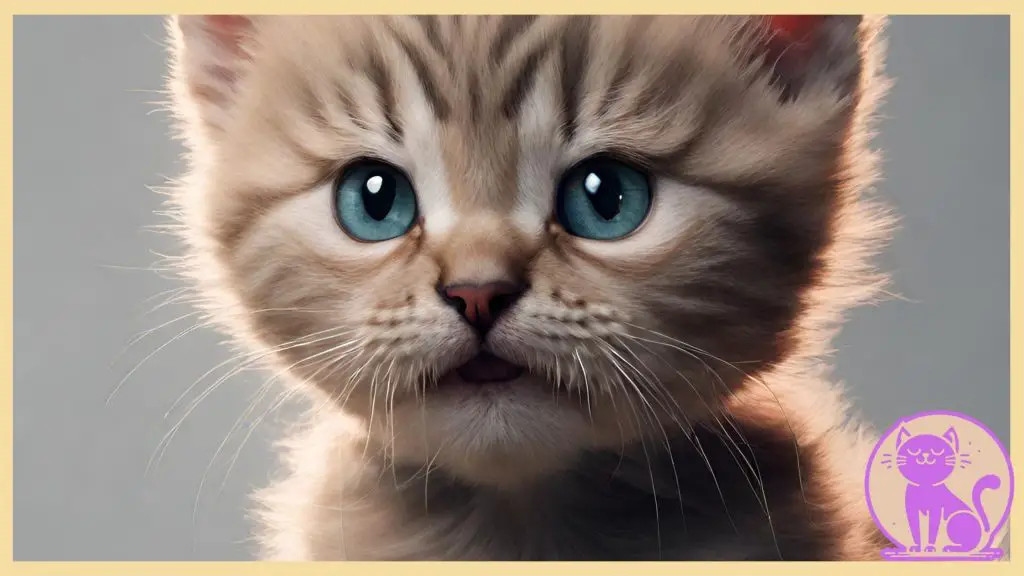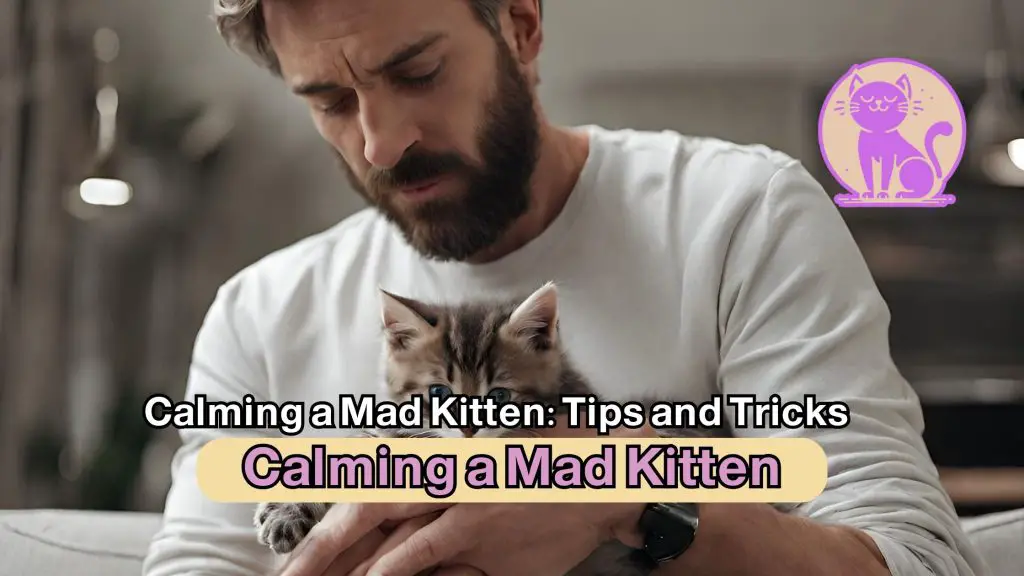Having a frisky kitten can bring limitless joy and entertainment to any home. Yet, when your furry friend exhibits signs of agitation, understanding and applying calming techniques for kittens becomes essential. Owners seeking kitten behavior management solutions need not worry; this article is dedicated to helping you turn those exasperating moments into peaceful ones. Take a deep breath and prepare yourself for insightful strategies to ensure your kitten thrives in a tranquil and loving environment.
Understanding Your Mad Kitten’s Behavior

Managing a kitten’s behavior can be a challenge, as their moods can swiftly shift from playfully energetic to startlingly aggressive. Mastering the ability to discern these mood swings is crucial for any pet owner. In this section, we delve into the causes behind your kitten’s agitation, identify the signs of stress, and explain how to distinguish between a kitten’s innocent play and worrying aggression.
Common Reasons for Agitation in Kittens
Kittenhood is a period filled with explorations and learning. However, what might seem like a kitten’s paradise can sometimes become overwhelming, leading to agitation. Factors like environmental changes, lack of socialization, or even hunger can significantly impact your feline’s mood. Below, we examine critical triggers that may be causing your kitten stress.
Identifying Signs of Stress or Anger
Elevated stress levels in kittens can manifest as various behavioral signs. Recognizing these signs of kitten stress is paramount in providing timely care and preventing escalation. Look for changes in body language, such as flattened ears, a puffed-up tail, or hissing, which indicate discomfort and possibly fear or anger in your kitten.
The Difference Between Playfulness and Aggression
Understanding the nuances between a playful kitten and one exhibiting kitten aggression is key to maintaining harmony at home. Playful behaviors are usually non-destructive and involve a lot of running, pouncing, or light nibbling. In contrast, aggressive actions are more intense and can include biting or scratching with a purpose to harm. By learning to read your kitten’s body language and vocal cues, you can better manage their energy and ensure a joyful and safe environment for both you and your pet.
| Behavior | Playful | Aggressive |
|---|---|---|
| Eyes | Dilated pupils | Narrowed or fixated gaze |
| Ears | Forward or slightly to the side | Flat against the head |
| Tail | Upright, may wave gently | Puffed up, rigid or thrashing |
| Vocalization | Quiet chirps or trills | Hissing or growling |
| Biting | Light nibbling without pressure | Firm biting that may break the skin |
Creating a Calming Environment for Your Kitten
Establishing a stress-free habitat for kittens is essential for their development and happiness. Just like humans, kittens thrive in environments that fulfill their need for peace and comfort. A well-considered space contributes markedly to peaceful kitten surroundings, forging a secure foundation for your pet’s well-being.
Creating this environment goes beyond having a cozy bed; it’s about appealing to all your kitten’s senses and providing a sanctuary from stress. Here are some practical steps to achieve that:
- Controlled Sound Levels: Loud noises can be frightening. Ensure your space is insulated from disruptive sounds.
- Visual Stimulation: Kittens enjoy watching the world go by. Safe access to a window can provide hours of entertainment.
- Safe Hideaways: A hidden nook can be a retreat for your kitten when it feels overwhelmed.
- Consistent Layout: Frequent changes in layout can disorient kittens; maintain consistency for a sense of security.
- Scent-Free Zone: Strong smells can be unpleasant or unsettling for kittens. Avoid using heavily scented products.
- Calm Human Interaction: Your energy affects your kitten. Approach your pet calmly and speak in soft, reassuring tones.
Ultimately, your goal is to nurture a loving environment that allows your kitten to grow into a well-adjusted adult cat. Paying attention to the details of their environment sets the tone for a happy, stress-free life. Remember, a serene home atmosphere is as beneficial for you as it is for your furry companion.
Interaction Techniques: How to Handle a Mad Kitten

When faced with a mad kitten, it’s crucial to approach the situation with patience and understanding. The key to handling an agitated young feline lies in gentle kitten interaction and mindful observation of their body language. Let’s explore the proper ways to hold a kitten that may be feeling overstimulated or fearful and how soothing touches can have a calming effect.
Proper Ways to Pick Up and Hold a Kitten
To ensure a feeling of security for your kitten, begin by gently placing one hand behind their front legs and the other supporting their hindquarters. Here’s a step-by-step guide for safe and comforting handling:
- Approach your kitten calmly to avoid further stress.
- Gently scoop them up from under the chest, placing one hand around the front legs.
- Support the hind legs and bottom with your other hand firmly but tenderly.
- Hold your kitten close to your chest to provide additional security.
- Avoid holding them too tightly, as this can cause anxiety or discomfort.
- Refrain from picking up your kitten by the scruff or limbs, as this is inappropriate and can be harmful.
- Frequent, gentle holding sessions can help your kitten acclimate to being handled.
Using Soothing Touches to Calm Your Kitten
Gentle petting can be a highly effective tool for calming a mad kitten. Soft strokes should be gentle and directed towards the areas where kittens feel most comfortable being touched, such as the base of the ears, under the chin, and along the back. Here’s how to use touch to nurture a bond and instill tranquility:
- Begin by slowly extending your hand and allowing the kitten to sniff and become acquainted with your scent.
- Once they seem comfortable, initiate petting in their preferred areas, paying close attention to their reactions.
- If your kitten appears receptive, you can gradually increase the duration of the petting sessions.
- Observe for signs of relaxation such as purring, kneading, or slow blinking, which indicate they are content and calm.
- Should your kitten retreat or show signs of discomfort, pause and give them space. Forcing interaction can lead to stress.
- Use your voice in a soft, soothing tone to accompany your touches and deepen the sense of calm.
Repetition of these gentle kitten interaction methods can make a world of difference when handling a mad kitten. Consistently adhering to these practices not only calms your feline friend but also reinforces a trusting and affectionate relationship between you and your pet.
Mad Kitten: De-escalation Strategies
If your home has recently become a playground for a hyperactive furball, you’re probably wondering about calming a mad kitten and looking for effective de-escalation techniques for kittens. The key lies in understanding that kittens, with their mischievous nature, require a gentle and patient approach. Quick mood changes are entirely normal, and there are strategies that can help ease their excessive energy or frustration.
Start with a Soothing Voice: Your tone can have a calming effect. Speak softly to your kitten, using its name and maintaining a tranquil demeanor to help alleviate its stress.
Offer a Safe Space: Kittens need an area where they can retreat and feel secure. Make sure your kitten has access to a quiet corner, a cozy bed, or a comfortable hiding spot.
Remember, creating a safe and loving environment is crucial for the well-being of your young feline friend.
Implement a Distraction Technique: Sometimes, the best way to handle an overexcited kitten is to redirect its attention. Interactive toys that encourage play can be a great way to shift its focus from destructive behavior to constructive amusement.
- Feather wands
- Ball tracks
- Soft stuffed toys
Engage in Play Before Bed: Tiring your kitten out before sleep time can help to ensure a more peaceful night. A good play session can exhaust the excess energy, leading to a calmer kitten.
Consider Pheromone Diffusers: These devices emit a synthetic version of the pheromones mother cats produce to calm their kittens. They can be particularly useful in creating a soothing atmosphere for your kitten.
Understanding and employing these strategies can not only help in calming a mad kitten but also strengthen the bond between you and your pet. Patience and consistent application of these de-escalation techniques for kittens will encourage a harmonious living situation, benefiting both the kitten and the owner.
Utilizing Toys and Playtime to Redirect Energy

For the caretaker of an exuberant feline, discovering the best toys for energetic kittens is crucial in diverting their boundless vigor. A thoughtful selection of amusements can transform potential chaos into an occasion for healthy playtime for active kittens. Below, we delve into the art of choosing toys that not only entertain but also benefit your kitten’s well-being.
Choosing the Right Toys for an Energetic Kitten
When selecting the perfect toys, consider your kitten’s individual personality and preferences. Some toys, like feather wands or laser pointers, encourage your kitten to leap and chase, allowing them to exercise their natural predatory instincts. Others, such as crinkle balls or tunnels, provide an interactive experience that can keep your kitten engaged for hours on end. It’s imperative to offer a diverse array of toys to cater to all aspects of your kitten’s lively spirit.
| Type of Toy | Benefits | Suggested Playtime |
|---|---|---|
| Chase Toys (e.g., laser pointers, balls) | Facilitates aerobic activity; hones hunting skills | 15-20 minutes, twice daily |
| Interactive Toys (e.g., feather wands, teasers) | Strengthens bond between kitten and owner; encourages natural behaviors | 10-15 minutes, multiple times per day |
| Puzzle Feeders | Stimulates mind; slows down eating pace for better digestion | Use during meal times |
| Climbing Structures (e.g., cat trees, shelves) | Provides exercise; satisfies climbing urge; offers safe perch | Available at all times |
| Tunnels and Hideouts | Encourages exploration; serves as a haven for rest | Available at all times |
Interactive Games to Tire Out Your Kitten
Alongside a thoughtfully curated toy collection, engaging in interactive games is essential to channel your kitten’s exuberance productively. Simple yet stimulating games like “fetch” with soft toys or “hunt the treat” with a scatter of kibble pieces across the room can be surprisingly effective. These activities not only tire out a spirited kitten but also strengthen the emotional link with their human companions.
- Chase the Light: Utilize a flashlight or laser pointer and watch your kitten pounce and dart after the elusive light.
- Box Bop: Repurpose cardboard boxes with cutout holes for a game of peek-a-boo and paw swatting.
- The Fishing Game: A feather wand mimicking the erratic movements of prey can provide endless delight and a serious workout.
- Hide and Seek: Position treats within puzzle toys or under cups and challenge your kitten to discover them.
- Treat Trails: Encourage natural hunting behavior by leaving a trail of treats for your kitten to sniff out and forage.
By incorporating the right mix of toys and engaging playtime routines, you are setting a foundation for your kitten to release pent-up energy productively, curbing any mad dashes around the house. This proactive approach is a game-changer for both the kitten’s development and the harmony of your home.
Training Techniques to Manage Kitten Tantrums

When it comes to kitten training methods, a strategic approach is key in preventing kitten tantrums before they start. Understanding the triggers and effectively redirecting your kitten’s energy can help establish good behavior and a harmonious relationship. Below, we offer proven strategies for managing those mischievous outbursts.
- Positive Reinforcement: Reward your kitten with treats or affection for calm behavior to encourage more of the same.
- Time-outs: When a tantrum occurs, a brief time-out in a quiet, safe space can help your kitten settle down.
- Ignore Bad Behavior: Avoid giving attention during a tantrum as it may reinforce the behavior.
- Consistency is Crucial: Applying the same response to tantrums will help your kitten learn what is expected.
Developing a training routine that combines these elements with your kitten’s personality in mind is essential for success. Regular, short training sessions will reinforce good behavior and help with preventing tantrums. Remember, patience and consistency are your best tools when guiding your little companion.
| Technique | Description | Benefits |
|---|---|---|
| Clicker Training | Using a clicker to mark desired behavior, followed by a reward. | Clear communication and faster learning. |
| Play Therapy | Structured play sessions that allow for energy expenditure. | Reduces excess energy that can lead to tantrums. |
| Command Training | Teaching specific commands to refocus attention during heightened states. | Provides mental stimulation and control over behavior. |
Implementing these kitten training methods can dramatically reduce the frequency and intensity of kitten tantrums. Each cat is unique, so it’s vital to tailor your approach to your kitten’s individual needs and progress. With time and proper training, your loving pet will grow into a well-behaved companion.
Incorporating a Relaxing Diet and Treats
A well-considered diet can play a pivotal role in managing your kitten’s temperament. Just like in humans, the right balance of nutrients can promote a calm and content disposition in our feline companions. Delving into the specifics, we’ll explore the influence a diet can have on a kitten’s behavior, along with the additional benefits of integrating specially formulated calming treats into their regimen.
Nutritional Considerations for a Balanced Feline Temperament
When designing a kitten diet for temperament, it’s crucial to consider the balance of proteins, fats, and carbohydrates. These macronutrients serve not only to fuel the body but also to stabilize mood and reduce anxiety. The inclusion of Omega-3 fatty acids, for instance, has been shown to support brain health and potentially lead to a calmer temperament in kittens. Moreover, ensuring an adequate intake of B-vitamins can aid in the regulation of stress levels.
Calming Treats and Their Effectiveness
In addition to a well-balanced diet, calming treats for kittens can be a valuable tool in soothing your pet’s nerves. These treats often contain ingredients like chamomile, L-theanine, or tryptophan, known for their natural calming effects. While the efficacy may vary from one kitten to another, these treats can be a helpful aid in conjunction with other calming techniques.
| Ingredient | Benefits | Commonly Found In |
|---|---|---|
| Chamomile | Mild sedative properties, relieves anxiety | Herbal calming treats |
| L-Theanine | Promotes relaxation without drowsiness | Chewable tablets, soft chews |
| Tryptophan | Pre-cursor to serotonin, enhances mood | Calming diets, treats |
The Role of a Regular Routine in Calming Your Kitten

A well-structured kitten routine is key to maintaining calm in kittens. Regularity in feeding, play, and rest schedules provides kittens with a sense of security and stability that can greatly reduce stress and agitation. Let’s delve into the core components of a solid routine designed to foster a serene and balanced kitten.
Feeding: Consistent meal times not only regulate your kitten’s hunger but also instill a pattern that aligns with their natural circadian rhythms, contributing to overall calm.
Playtime: Allocating specific times for play can help manage your kitten’s bursts of energy, ensuring that they’re more relaxed during downtime.
Training: Short, regular training sessions can provide mental stimulation for your kitten and reinforce desirable behavior through positive reinforcement.
| Activity | Time | Benefits |
|---|---|---|
| Feeding | 7 AM / 6 PM | Encourages digestive health and pattern predictability |
| Play and Exercise | 10 AM / 9 PM | Energy expenditure and stimulation, leading to better rest |
| Training | 4 PM | Enhances obedience and provides routine structure |
| Quiet Time | 11 PM – 6 AM | Promotes restful sleep and behavioral calm |
Incorporating these elements into your kitten’s daily life establishes predictability, which is a crucial factor in maintaining calm in kittens. As each kitten is unique, tweaking the routine to suit individual needs is recommended for the best results.
When to Seek Professional Help
There comes a point in managing kitten behavior when the expertise of professionals may be necessary. Recognizing the signs that your furry companion needs more than your nurturing home environment can be pivotal for their wellbeing. At times, behaviors exhibited by kittens can be concerning, and discerning whether these instances require the intervention of behavioral experts for kittens or additional professional help for kitten behavior becomes essential.
Behavioral Experts and Feline Specialists
The realm of feline behavior is complex, and sometimes a kitten’s actions are a cry for specialized help. Behavioral experts, often equipped with certifications in animal behavior, are trained to understand the nuances of feline interactions. These professionals apply evidence-based methods and tailor interventions for each unique kitten’s needs, ensuring the best outcomes for both the pet and the owner.
Signs That Your Kitten Needs More Than Just Home Care
Identifying the symptoms that suggest the need for professional assistance is crucial in taking timely action. Below are significant signs to watch for:
- Aggression that does not subside with basic training or socialization
- Marked changes in behavior or mood that cannot be attributed to a clear cause
- Persistent litter box issues or unusual changes in toileting habits
- Excessive vocalization or destructive behavior that resists correction
- Visible signs of anxiety or stress that affect your kitten’s quality of life
If your kitten exhibits any of these behaviors consistently, it might be time to seek professional help for kitten behavior. A collaboration between pet owners and specialized behavioral experts for kittens can significantly enhance the feline-human bond, leading to a peaceful and happy co-existence.
Sharing Success Stories: Calming Techniques That Worked

Every kitten owner’s journey is filled with unique challenges and triumphs, especially when it comes to soothing their mischievous little companions. In the realm of kitten rearing, success often bubbles up from shared experiences and the wisdom of try-and-test approaches. Gleaned from the anecdotes of fellow feline aficionados, this section aims to instill confidence through successful kitten calming stories, and underscore the value of patience with kittens.
Case Studies from Other Kitten Owners
Among countless narratives, a particularly heartwarming story reverberates within the kitten owner community. One tale recounts how interactive play sessions, coupled with a variety of stimulating toys, diverted a frisky kitten’s energy into positive outlets, turning rambunctious behavior into purring exhaustion. Similarly, another owner discovered that establishing a routine playtime could significantly ease her kitten’s anxiety, revealing the profound impact of a structured schedule. These cases affirm that patience and occupationally strategic playtime can transform behavioral challenges into delightful bonding sessions.
The Importance of Patience and Consistency
Patience is not simply a virtue but a necessity in the delicate process of fostering a tranquil bond with a kitten. Consistency in applying calming techniques, reinforced by the reassurance of a steady routine, has been pivotal in more serene feline behavior. The stories shared by seasoned owners serve as testimonies to the power of a steady hand and a gentle voice. By embracing patience and consistency, even the most spirited kittens can learn to navigate their energy in playful yet peaceful ways.
FAQ
Q: What are some calming techniques for a mad kitten?
A: Calming a mad kitten can be achieved through gentle petting, speaking in a soft voice, providing a quiet environment, or engaging in play with appropriate toys to redirect their energy. Additionally, maintaining a consistent routine and using calming pheromone diffusers or sprays can also help soothe a stressed kitten.
Q: How can I tell if my kitten’s behavior is playful or aggressive?
A: Playful kittens often have a relaxed body posture and may engage in behaviors such as pouncing, chasing, or batting with soft paws. Aggressive behavior might include hissing, growling, swatting with claws extended, and having a tense body posture. Observing the context of the behavior and the kitten’s body language will help you differentiate between the two.
Q: What should I include in my kitten’s environment to keep them calm?
A: Provide your kitten with a stress-free habitat by incorporating comfortable bedding, scratching posts, hiding spots, and safe toys. Ensure the space is quiet and sheltered from loud noises. Consistency with feeding times and having a clean litter box also contribute to a peaceful environment.
Q: How do I properly pick up and soothe a mad kitten?
A: To pick up a kitten, gently place one hand behind their front legs and support their back legs and bottom with the other hand. Once securely held, hold the kitten close to your body to provide comfort. Use a calm and soft tone to speak to them and pet them gently to soothe them.
Q: What toys and activities are best for energetic kittens?
A: Look for toys that simulate hunting behavior, such as wand toys with feathers, mice toys that move unpredictably, and balls that they can chase. Engaging in interactive play sessions and games that encourage your kitten to jump, chase, and pounce can help tire out an energetic kitten and reduce their mischievous behavior.
Q: Can diet affect my kitten’s behavior?
A: Yes, a balanced diet can contribute to a kitten’s overall well-being and temperament. High-quality kitten food that’s appropriate for their age and health needs is crucial. Calming treats that contain ingredients like L-theanine or chamomile may also have a soothing effect on some kittens, but they should be used in moderation as part of a balanced diet.
Q: When is professional help needed for a kitten’s behavior?
A: Consider seeking professional help if your kitten exhibits prolonged aggressive behavior, does not respond to calming methods, shows signs of extreme fear or stress, or if there are sudden changes in behavior that cannot be addressed through routine care and environmental management. A behavioral expert or feline specialist can provide tailored advice and support.
Q: What key elements contribute to a successful kitten calming routine?
A: Consistency in handling, feeding, and playtime schedules is essential in establishing a calming routine. Providing daily times for interaction and quiet periods can help create a balanced day for your kitten. Patience and positive reinforcement techniques are also important to reinforce calm behaviors over time.








